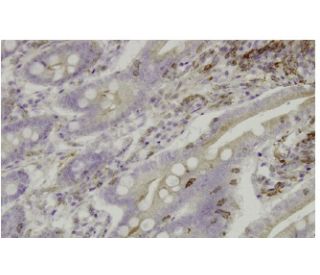

BAR Antibody (L-16): sc-101217
- BAR Antibody (L-16) is a mouse monoclonal IgG2a κ BAR antibody provided at 50 µg/0.5 ml
- raised against recombinant BAR of human origin
- recommended for detection of BAR of human origin by IF, IHC(P) and ELISA
- At present, we have not yet completed the identification of the preferred secondary detection reagent(s) for BAR Antibody (L-16). This work is in progress.
QUICK LINKS
SEE ALSO...
BAR Antibody (L-16) is a mouse monoclonal IgG2a kappa light chain antibody that detects BAR protein of human origin by immunofluorescence (IF), immunohistochemistry with paraffin-embedded sections (IHCP), and enzyme-linked immunosorbent assay (ELISA). Anti-BAR antibody (L-16) is available as the non-conjugated form. BAR protein, known as the bifunctional apoptosis regulator, plays a crucial role in regulating apoptosis, a vital process for maintaining cellular homeostasis and eliminating damaged or unwanted cells. Located primarily in cytoplasm and mitochondria, BAR protein interacts with key components of both extrinsic and intrinsic apoptotic pathways, thereby modulating apoptotic signaling. BAR protein′s unique structure includes several functional domains, such as the death effector domain (DED) that allows inhibition of apoptosis at the receptor level, and a domain that interacts with the Bcl-2 family of proteins, which are critical regulators of mitochondrial apoptosis. This multifunctionality positions BAR protein as a potential scaffold protein that integrates various signaling pathways, highlighting BAR protein′s importance in the intricate balance of cell survival and death. BAR protein′s ability to negatively regulate apoptosis underscores its significance in cancer biology and therapeutic strategies aimed at manipulating apoptotic pathways.
Alexa Fluor® is a trademark of Molecular Probes Inc., OR., USA
LI-COR® and Odyssey® are registered trademarks of LI-COR Biosciences
BAR Antibody (L-16) References:
- BAR: An apoptosis regulator at the intersection of caspases and Bcl-2 family proteins. | Zhang, H., et al. 2000. Proc Natl Acad Sci U S A. 97: 2597-602. PMID: 10716992
- Programmed cell-death regulation: basic mechanisms and therapeutic opportunities. American Association for Cancer Research Special Conference: Lake Tahoe, CA, USA, 27 February-2 March 2000. | Roy, S. and Nicholson, DW. 2000. Mol Med Today. 6: 264-6. PMID: 10950603
- Mechanisms of apoptosis. | Reed, JC. 2000. Am J Pathol. 157: 1415-30. PMID: 11073801
- Inactivation of caspase-8 on mitochondria of Bcl-xL-expressing MCF7-Fas cells: role for the bifunctional apoptosis regulator protein. | Stegh, AH., et al. 2002. J Biol Chem. 277: 4351-60. PMID: 11733517
- Bifunctional apoptosis inhibitor (BAR) protects neurons from diverse cell death pathways. | Roth, W., et al. 2003. Cell Death Differ. 10: 1178-87. PMID: 14502241
- Caspases: potential targets for regulating cell death. | Philchenkov, A. 2004. J Cell Mol Med. 8: 432-44. PMID: 15601572
- Inhibition of death receptor signals by cellular FLIP. | Irmler, M., et al. 1997. Nature. 388: 190-5. PMID: 9217161
- Bcl-XL cooperatively associates with the Bap31 complex in the endoplasmic reticulum, dependent on procaspase-8 and Ced-4 adaptor. | Ng, FW. and Shore, GC. 1998. J Biol Chem. 273: 3140-3. PMID: 9452422
- BCL-2 family: regulators of cell death. | Chao, DT. and Korsmeyer, SJ. 1998. Annu Rev Immunol. 16: 395-419. PMID: 9597135
Ordering Information
| Product Name | Catalog # | UNIT | Price | Qty | FAVORITES | |
BAR Antibody (L-16) | sc-101217 | 50 µg/0.5 ml | $333.00 |
